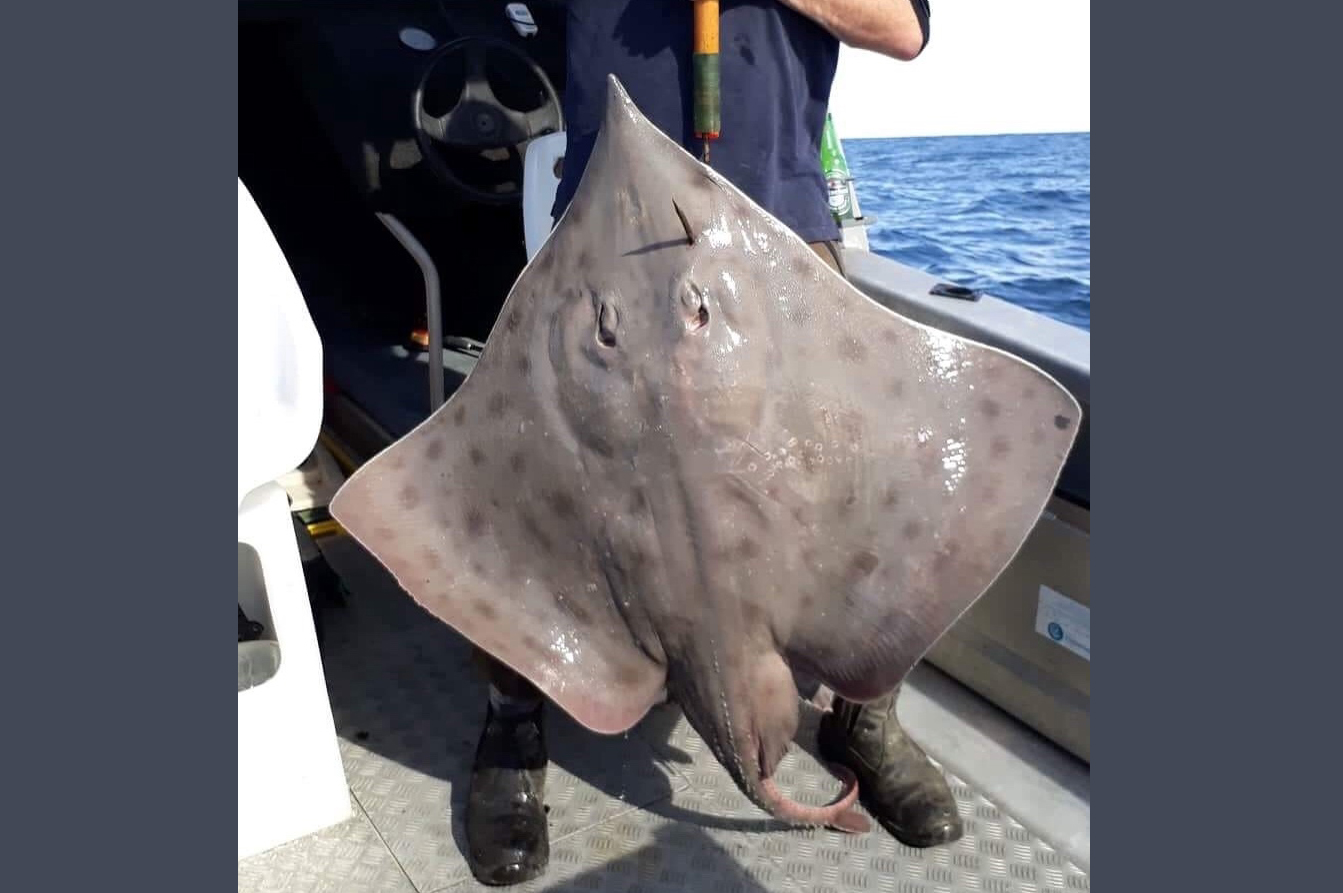- Classification
- CHONDRICHTHYES
- RAJIFORMES
- RAJIDAE
- Dipturus
- innominatus
New Zealand Smooth Skate, Dipturus innominatus (Garrick & Paul 1974)

A New Zealand Smooth Skate, Dipturus innominatus, from west of Cape Palliser, New Zealand, August 2018, depth, 220 m (released). Source: Lisa Bennett / iNaturalist.org. License: CC By Attribution-NonCommercial
Summary:
A large greyish to greyish-brown deepwater skate with large darker regularly-spaced spots or blotches on the disc and tail, and a whitish and blotchy pale grey to brownish underside. The New Zealand Smooth Skate has the tail much shorter than disc, an acutely pointed snout and the anterior margin of the disc is concave.
Cite this page as:
Bray, D.J. 2020, Dipturus innominatus in Fishes of Australia, accessed 04 Jul 2025, https://fishesofaustralia.net.au/Home/species/5543
New Zealand Smooth Skate, Dipturus innominatus (Garrick & Paul 1974)
More Info
|
Distribution |
Norfolk Ridge in the Tasman Sea, within the Australian EEZ. Elsewhere the species occurs in New Zealand. Occurs on soft bottom habitats in continental shelf and upper slope waters, mostly at depths of 0-500 m, but has been recorded to 1,300 m. |
|
Features |
Predorsal-caudal vertebrae 50-53. Tail much shorter than disc; snout acutely pointed, anterior disc margin concave. Subadults usually lack prickles dorsally on the disc; medium to large individuals develop prickles on the snout, in a middorsal-trunk band, and posterolaterally on the disc, ventrally on the gill and abdominal regions; females are extensively prickled below; the tail is relatively narrow, usually with 1-3 row of spines. |
|
Feeding |
Feeds on crustaceans and fishes. |
|
Biology |
Reproduction is oviparous and fecundity is likely to be low. Females lay paired egg capsules with horn-like projections, and the embryos feed solely on yolk. The species attains a maximum age of about 24 years. Males mature at about 93 cm pelvic length (PL, tip of the snout to the posterior margin of the pelvic fins) and 8 years of age. Females mature at 112 cm PL and 13 years of age. Pups hatch from at about 10-15 cm P, 20-23 cm TL. |
|
Fisheries |
Commercially fished in New Zealand waters, mostly as by-catch in deepwater benthic trawl and longline fisheries. |
|
Etymology |
The specific name innominata is from the Latin (= not) and nominatus (= named), in reference to the species' not having been given a scientific name even though it had been known for a long time. |
|
Species Citation |
Raja innominata Garrick & Paul 1974, Journal of the Royal Society of New Zealand 4(3): 357, figs 6-7. Type locality: Cape Campbell, New Zealand. |
|
Author |
Bray, D.J. 2020 |
|
Resources |
New Zealand Smooth Skate, Dipturus innominatus (Garrick & Paul 1974)
References
Ayling, T. & Cox, G.J. 1982. Collins Guide to the Seafishes of New Zealand. Auckland : Collins 343 pp. 48 pls 475 figs.
Beentjes, P., Bull, B., Hurst, R.J. & Bagley, N.W. 2002. Demersal fish assemblages along the continental shelf and upper slope of the east coast of the South Island, New Zealand. New Zealand Journal of Marine and Freshwater Research 36: 197-223.
Cox, G. & Francis, M. 1997. Sharks and Rays of New Zealand. Christchurch : Canterbury University 68 pp.
Finucci, B. & Kyne, P.M. 2018. Dipturus innominatus. The IUCN Red List of Threatened Species 2018: e.T41799A116736852. https://dx.doi.org/10.2305/IUCN.UK.2018-2.RLTS.T41799A116736852.en. Downloaded on 27 April 2020.
Finucci, B., Duffy, C.A.J., Francis, M.P., Gibson, C. & Kyne, P.M. 2019. The extinction risk of New Zealand chondrichthyans. Aquatic Conservation: Marine and Freshwater Ecosystems 29(5): 783-797
Forman, J. & Dunnn, M.R. 2012. Diet and scavenging habits of the smooth skate Dipturus innominatus. Journal of Fish Biology 80(5): 1546–1562, https://doi.org/10.1111/j.1095-8649.2012.03255.x
Francis, M.P., Ó Maolagáin, C. & Stevens, D. 2001. Age, growth, and sexual maturity of two New Zealand endemic skates, Dipturus nasutus and D. innominatus. New Zealand Journal of Marine and Freshwater Research 35: 831-842.
Garrick, J.A.F. & Paul, L.J. 1974. The taxonomy of New Zealand Skates (Suborder Rajoidea), with descriptions of three new species. Journal of the Royal Society of New Zealand 4 (3): 345–377, https://doi.org/10.1080/03036758.1974.10419402
Last, P.R. Séret, B., Stehmann, M.F.W. & Weigmann, S. 2016. Skates, Family Rajidae. pp. 204-363 in Last, P.R., White, W.T., Carvalho, M.R. de,, Séret, B., Stehmann, M.F.W & Naylor, G.J.P (eds.) Rays of the World. Clayton South, Victoria : CSIRO Publishing 790 pp.
Last, P.R. & Stewart, A.L. 2015. Family Rajidae, Hardnose skates. pp. 176–179 in Roberts, C.D., Stewart, A.L. & Struthers, C.D. (eds) The Fishes of New Zealand. Wellington : Te Papa Press Vol. 2 pp. 1-576.
Last, P.R., Weigmann, S. & Yang, L. 2016. Changes to the nomenclature of the skates (Chondrichthyes: Rajiformes). pp. 11-34 in Last, P.R., White, W.T., Carvalho, M.R. de,, Séret, B., Stehmann, M.F.W & Naylor, G.J.P (eds.) Rays of the World. Clayton South, Victoria : CSIRO Publishing 790 pp.
Last, P.R. & Yearsley, G.K 2002. Zoogeography and relationships of Australasian skates (Chondrichthyes: Rajidae). Journal of Biogeography 29(12): 1627-1641.
Paulin, C., Stewart, A., Roberts, C. & McMillan, P. 1989. New Zealand fish: a complete guide. National Museum of New Zealand Miscellaneous Series 19: 1-279


